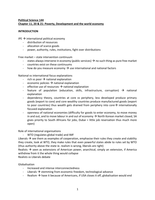Political Science 144
Chapter 11, 20 & 21: Poverty, Development and the world economy
INTRODUCTION
IPE international political economy
- distribution of resources
- allocation of scarce goods
- power, authority, rules, institutions, fight over distributions
Free market – state intervention continuum
- states always intervene in economy (public services) no such thing as pure free market
- countries exist on these continuums
- how do you measure economy use international and national factors
National vs international focus explanations
- rich vs poor national explanation
- economic policies national explanation
- effective use of resources national explanation
- feature of population (education, skills, infrastructure, corruption) national
explanation
- dependency theory, countries at core vs periphery, less developed produce primary
goods (export to core) and core wealthy countries produce manufactured goods (export
to poor countries) thus wealth gets drained from periphery into core internationally
focused explanation
- openness of national economies (difficulty for goods to enter economy, to move money
in and out, and to move labour in and out of economy North Korean market closed, SA
gives priority to South Africans for jobs, Dubai = little job reservation thus much more
open)
Role of international organisations
- WTO (regulates global trade) and IMF
Liberals see them as examples of cooperation, emphasise their rules they create and stability
they create, look at WTO, they make rules that even powerful states abide to rules set by WTO
(thus authority above the state ie. realism is wrong, liberals are right)
Realists seen as extensions of American power, anarchical, simply an extension, if America
withdrew from it the whole thing would collapse
Realists vs Liberals debate
Globalisation
- Increased and intense interconnectedness
- Liberals stemming from economic freedom, technological advance
- Realism have it because of Americans, if USA closes it off, globalisation would end
1





